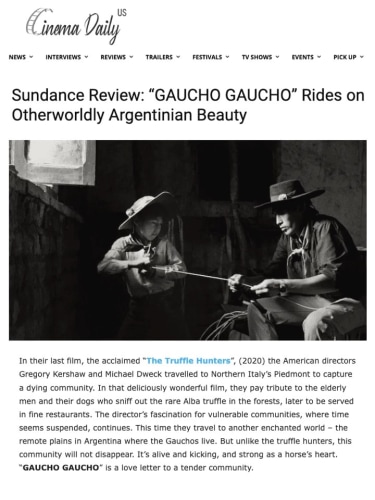Sundance Review: “GAUCHO GAUCHO” Rides on Otherworldly Argentinian Beauty
Cinema Daily
02/05/2024
Back
By Niclas Goldberg
In their last film, the acclaimed “The Truffle Hunters”, (2020) the American directors Gregory Kershaw and Michael Dweck travelled to Northern Italy’s Piedmont to capture a dying community. In that
deliciously wonderful film, they pay tribute to the elderly men and their dogs who sniff out the rare Alba truffle in the forests, later to be served in fine restaurants. The director’s fascination for vulnerable
communities, where time seems suspended, continues. This time they travel to another enchanted world – the remote plains in Argentina where the Gauchos live. But unlike the truffle hunters, this community will not disappear. It’s alive and kicking, and strong as a horse’s heart. “GAUCHO GAUCHO” is a love letter to a tender community.
The opening scene is mind-blowing. A man lies on the grass on top of a resting horse. Birds are chirping, the horse is breathing deeply, and the texture of the black and white image is strong. Soon the man gets up and whistles, and the horse follows. They walk together towards the eternal horizon. The scene captures how a gaucho tames a horse. By laying on the horse they synchronize their pulses, and the horse becomes one with the gaucho. In the next scene several gauchos ride horses over the plains in slow motion while we hear opera music. Immediately you are hypnotized and everything after is a pure pleasure to watch.
Gauchos are skilled horsemen and cowhands of the Argentinean and Uruguayan grasslands, and of Rio Grande do Sul in Brazil and southern Bolivia and Chile. Many compare them to horse-based cultures like the North American cowboys. They also became well-known in legend, folklore, and literature being an important part of their regional cultural tradition. From the 19th century they were much celebrated by South American writers and there is no surprise why the directors of “GAUCHO GAUCHO” became mesmerized by this culture, their patterns, and their stories. The filmmakers were welcomed and gained trust of families after spending months with them. Without a story in mind, and with no cameras, they were able to dig deeper and immerse themselves in the Gaucho’s lives. Organically the Gauchos forgot about the filmmakers, even when the cameras eventually were placed.
The film follows a few people, each of them captivating to observe and listen to. The scenes mostly shot by a static camera have spellbinding compositions and visual beauty. With an observational approach, the directors let the people go about their lives, their quiet moments, their conversations with family or friends or a priest. Every frame is a dazzling experience and has a quiet drama.
Several scenes capture the older generations providing their wisdom to the younger ones. Among them is a father, Solano, and his smiling son, Jony. He teaches his boy how to sharpen knives on a rock, another how to braid ropes. An old man with a white snowy beard, Lelo, sits in front of the boy by a table telling him how a manly Gaucho keeps quiet and “not to think one is better than others”. The boy listens with eyes wide open. It’s a simple scene, yet stunning.
Just as stunning are all the landscape scenes: a burning cactus, an old man harvesting a field, a condor soaring in the wind, a man dancing by a rock, others praying to God for rain, and preteens with sling shots etc. It’s magical. The power of the scenes reminds you of the Hungarian director Béla Tarr’s images. Those hypnotical black and white ones that drag you into their world. Almost biblical, very human, always potent – you are transported into them and feel what they feel.
Besides the static camera there are slow-motion shots, and the directors use sound and music to fit the images in ways only true artists can – the film won the Sundance special award for sound. The music choices are eclectic. We hear everything from the opera “Au fond du temple saint” from Bizet’s The Pearl Fisher to Argentinian rockers Los Gatos 1967 hit song “La Balsa ” and Alex Ebert’s “Truth.”
The directors shot only one shot a day for a long period of time – it took two years to film and edit the 143 shots. The conversations at the dinner table for example, that we see for two minutes, is in fact two hours long. For a Gaucho, gathering around the table sharing a meal together for hours, is an excuse to show love. Life revolves around that. It’s also the love to live in this community that makes the young generation stay and follow their parent’s footsteps.
One teenage girl, Guada, is learning how to break in horses and compete in the macho rodeo. We see her refuse to dress in a school uniform like the other girls. She insists on wearing only Gaucho clothes. She trains, gets hurt, and learns how to gain a horse’s trust. Her father, Tati, is her biggest supporter. It’s compelling to watch the scene where he expresses his pride for her, and the importance of watching and listening. The father emphasizes later that the film is called “GAUCHO GAUCHO”, which means “a real Gaucho”. But says it could also be called “This is what we are”.
Grade: A-